Recommended Books on Robotics for All Ages and Skill Sets
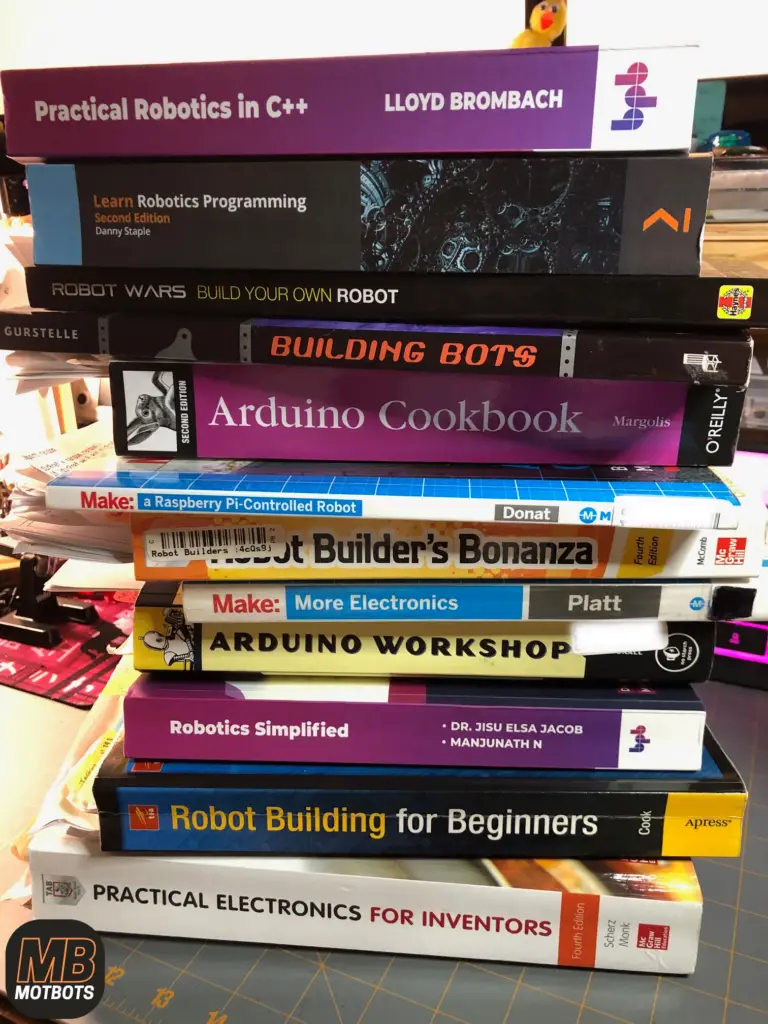
Whether you or someone you know are gaining an interest in robotics and looking to learn more about them, have had some experience in robotics and are looking to expand your skills, or are a seasoned robot maker; the following list of recommended books provide the reader with valuable information within their pages.
If you were to ask someone, “How can I learn robotics?”, most people would generally recommend a few things – like going to college, taking online courses, or reading a book. College is probably out of the question for most, since most people just want to learn robotics based on interest, not as a career. Online courses are fine, but a lot of times finding information on basic stuff is quite difficult for the average person just wanting to learn. Books however, are a great way to learn robotics, especially for those who don’t have much of a technical background and are looking into learning robotics purely out of curiosity.
There are all types of books for people of all ages and skill sets who genuinely want to learn robotics and how to build them. Books are a great resource to learn something new. In my experience, taking the time now and again reading a book is far superior than trying to scour the internet for a coherent and methodical way to learn something I’m totally ignorant about. The topic of robotics, especially, has been no different.
How The Following Book Recommendations Are Structured
- Age Ranges: The lists provided in this blog post are lists of recommended books on robotics divided into 2 age ranges:
- Kids and Preteens ages 6 – 12
- Teens and Adults ages 13+
- Skill Levels: Some, not all age ranges in the following lists provide recommended books based on 3 skill levels:
- Beginner
- Intermediate
- Advanced
- Skill Categories: In robotics, there is no one particular skill to learn, there are many. So, the following lists of books will be divided into 3 skill categories for age ranges and skill levels. Those skill categories are:
- Electronics: The foundation of robotics is electronics. As a robotics designer and maker, you will be exposed heavily in electronics, so knowing the basics is crucial and going beyond is beneficial.
- Robotics: It is obvious one would need to know about the fundamentals of robots and understand their mechanics and locomotion, circuitry and sensors, as well as their hardware and programming software that make robots function the way they do.
- Programming: There are many programming languages out there, but only a select few are considered essential or specific to the world of robotics. In the lists of programming languages that will be provided here in this blog post, only the Arduino, Python, C, or C++ programming languages are mentioned.
NOTE: The following lists of books on robotics assumes that the reader has no prior traditional training or education in electronics, robotics, or programming. The following lists of books are strictly recommendations for the given age ranges and skill sets. These lists are not extensive nor are they authoritative; they are strictly based on:
- opinion,
- or experience in having used them,
- and based on what is believed to be key-concepts one should explore and learn for any given age range and skill set.
Any books that I personally own and/or have used in the following lists have their authors highlighted in green.
Books for Beginners
The following are recommended books for the beginner into robotics. A beginner in this context is someone who has no prior experience in robotics or electronics. Books for beginners provide the basics to anyone wanting to learn robotics and are a great foundation to one’s personal educational endeavor into the magnificent world of robotics.
Kids and Preteens Ages 8 – 12
Electronics
- Electronics for Kids: Play with Simple Circuits and Experiment with Electricity!, by Oyvind Nydal Dahl: This book is geared towards kids interested in learning about electronics, a foundation of robotics. The book is split into two parts; Part 1 teaches about current, voltage and circuits by building experimental experience in electronics through projects. Part 2 furthers the reader’s exposure into electronics with more hands-on projects, such as soldering an LED circuit, turning a circuit into a touchscreen sensor, and creating electronic musical instruments!
- Awesome Electronics Projects for Kids: 20 STEAM Projects to Design and Build, by Colby Tofel-Grehl: Experimentation is an important skill to begin learning in the early stages of a budding robotics maker. This book offers 20 projects to get started in building electronics devices, such as a light-up birthday card, an automated bubble blower, alarm clock, and more!
- Scrappy Circuits, by Michael Carroll: This book describes itself as a “do-it-yourself” way to learn about electrical circuits. Within its pages kids will learn hands-on, safe, and inexpensive ways to build electronic circuits in a fun way.
Robotics
- My First Book of Robots, by HappyToons: This book is actually listed as a book for ages 5 and above. It provides the reader with engaging, high-quality images to help better learn the absolute basics of what robots are and how they work. Readers will learn how robots see, listen, talk, walk, feel, smell and more. This book even states that there’s a game inside!
- Robots (Scholastic Reader, Level 2), by Gail Tuchman: This book is geared to young kids 6 – 8 years of age. An industry leader in kids books and education, this Scholastic Reader, Level 2 book delves into the world of robotics in a way to spark the minds of young children.
- The Maker’s Guide to Building Robots: A Step-by-Step Guide to Ordering Parts, Using Sensors and Lights, Programming, and More, by Raúl Laperia and Andreu Marsal: This book is geared towards kids 8 – 12 years of age. This book teaches kids what robots are. There are also explanations into the origins of robots and their history.
- Robotics Engineering: Learn It, Try It!, by Ed Sobey: This book is geared toward kids 9 – 14 years of age. It provides them with the basics of robotics from a real-life expert and provides hands-on experience within its pages.
- Bots! Robotics Engineering: with Hands-On Makerspace Activities, by Kathy Ceceri: This book is self-described as being an action-packed book that explores the roles that robots play in our world. It offers loads of hands-on activities so kids can learn about robots and design them.
- Awesome Robotics Projects for Kids: 20 Original STEAM Robots and Circuits to Design and Build, by Bob Katovich: This book is loaded with fun and entertaining ways to design and build your own robots out of ordinary household items and things easily found in stores. Geared towards kids, this book will teach them how to build things like a scribblebot and two-legged walkers!
- Robot Magic: Beginner Robotics for the Maker and Magician, by Mario Marchese: This book is unique in the sense that it’s a beginner’s guide to creating robotics infused with magic. Backed by an industry leader in the maker space, Make:, it’s a great book for all ages.
Programming
- Python for Kids, 2nd Edition: A Playful Introduction to Programming, by Jason R. Briggs: This is a best-selling book on Python for kids. This book introduces kids into the programming language of Python, a programming language used extensively by hobbyists and professionals alike. Kids will learn the basics of programming using the Python programming language and by the end of the book will have programmed two games.
- Coding for Kids: Python: Learn to Code with 50 Awesome Games and Activities, by Adrienne Tacke: This book states that it offers 50 fun, interactive activities that teach them the basics of the Python programming language. It offers a lot of step-by-step guides into the fundamentals of Python in an enjoyable way to keep kids attentive and excited about coding.
Teens and Adults Ages 13+
Electronics
- Getting Started in Electronics, by Forrest M. Mims III: Considered a leading authority on his ability to teach electronics through his books, Forrest Mims’s book “Getting Started in Electronics” is a complete course on electronics. This book teaches the you the basics, takes you on a tour of analog and digital components, explains how they work, and shows you how they are combined for various applications. This book also includes circuit assembly tips and 100 electronic circuits and projects you can build and test yourself.
- Make: Electronics: Learning by Discovery: A hands-on primer for the new electronics enthusiast, by Charles Platt: This book explores the properties and applications of discrete components that are the fundamental building blocks of circuit design. You’ll learn about resistors, capacitors, transistors, inductors, diodes and integrated circuit (IC) chips. This book is a great resource to learn all the basics one needs in starting in electronics, a building block into the world of robotics.
- Electronics for Beginners: A Practical Introduction to Schematics, Circuits, and Microcontrollers, by Jonathan Bartlett: A statement from this book reads “If you’ve thought about getting into electronics, but don’t know where to start, this book gives you the information you need.” This book teaches concepts on basics “patterns” of resistor usage, goes over concepts to understand the requirements for circuits and how they are put together, as well as allow the reader to read and differentiate what various parts of the schematics do; an important skill to master early on in your studies.
- Practical Electronics for Inventors, by Paul Scherz and Simon Monk: I actually own this book and it provides a wealth of information from the beginner level up to an advanced level. If you’re in the market for getting yourself a book on electronics to really learn as much as you can on the subject material, then this book is an excellent choice. This book will provide a strong foundation in your electronics knowledge and skills that will carry directly over to everything you’ll do in robotics.

Robotics
- Robotics: Everything You Need to Know About Robotics from Beginner to Expert, by Peter McKinnon: This book guides you into everything you need to know about robotics from beginner to expert. This book states that you’ll learn the history of robotics, learn the 3 Rules, and meet the very first robots, plus much more.
- Homemade Robots: 10 Simple Bots to Build with Stuff Around the House, by Randy Sarafan: This book proclaims that it is a beginner’s guide to building a wide range of mobile, autonomous bots using common household materials. Its 10 creative and easy-to-follow projects are designed to maximize fun with minimal effort. The book also states that there is no electronics experience necessary from the reader, so this book fits-the-bill for someone looking to get their feet wet into the world of robot design and building.
- Robot Building for Beginners, Third Edition, by David Cook: I bought the second edition of this book, probably not long after it was published in 2009, and it was the book that really started me off in building my own robots. The second edition walked me through building a robot that used photo-resistors to help the bot see where it was going and designed all in a plastic sandwich container. It was like seeing a creation I built on my own think for itself! The robot described and built in this book is battery powered and about the size of a lunch box. It is autonomous; that is, it isn’t remote controlled. This book is an excellent step in the direction of learning how to build robots and learning so many concepts on both electronics and robotics at the same time. I highly recommend it.
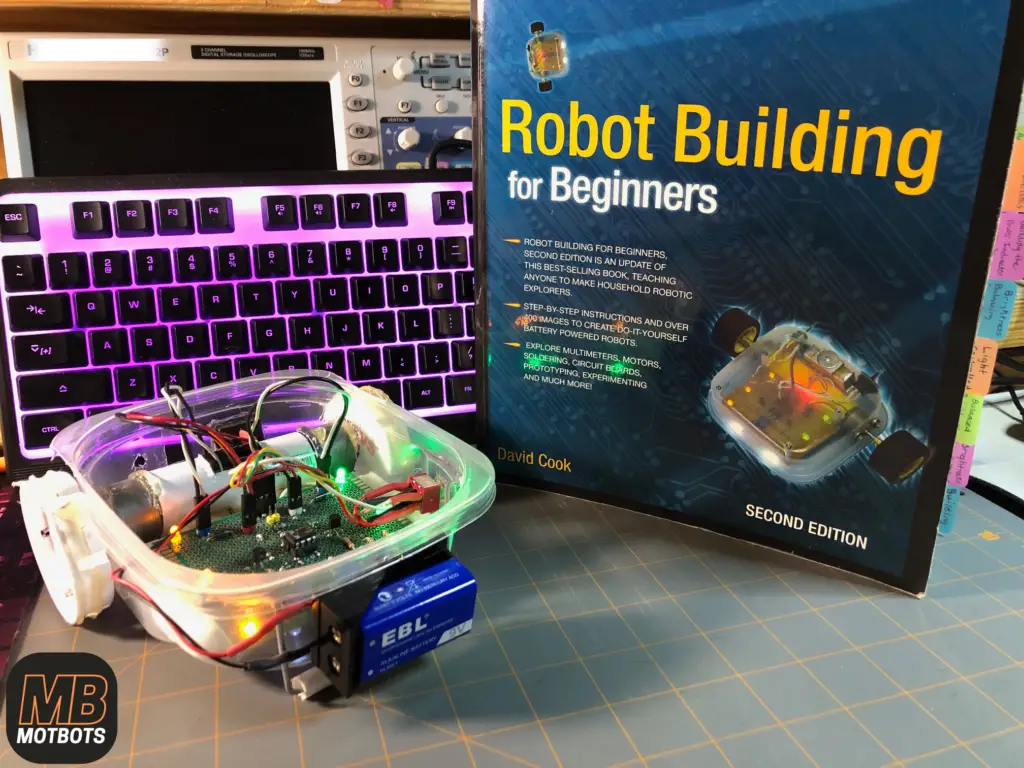
- Robotics Simplified: An Illustrative Guide to Learn Fundamentals of Robotics, Including Kinematics, Motion Control, and Trajectory Planning, by Dr. Jisu Elsa Jacob and Manjunath N: I actually own and have read this book. It’s not the best, but it is still good and very informative. You may need to pair this book with other resources, such as videos on YouTube from Northwestern Robotics or a supplemental book such as Robotics: Everything You Need to Know About Robotics from Beginner to Expert, by Peter McKinnon. This book includes key concepts of robotics, including modeling, controlling, and programming. The book introduces the reader to robotics kinematics, a key topic to learn for any robotics enthusiast.
Programming
- Learn Electronics with Arduino: An Illustrated Beginner’s Guide to Physical Computing, by Jody Culkin: This book states that it is an introduction to physical computing with the Arduino microcontroller platform. This book has the novice in mind, so it introduces to the reader basic electronics theory and programming concepts, as well as to digital and analog inputs and outputs. It is written for absolute beginners with no prior knowledge of electronics or programming.
- Getting Started With Arduino: The Open Source Electronics Prototyping Platform, by Massimo Banzi: From an author with a pretty cool sounding name, this book offers the reader an introduction into the Arduino architecture and helps you get started in prototyping your ideas right away. What you’ll learn is the Arduino board and its software environment, basics of electricity and electronics, drawing schematic diagrams, and so much more.
- Arduino Workshop: A Hands-On Introduction with 65 Projects, by John Boxall: I actually purchased the 1st edition of this book years ago and have gone through it in its entirety. It was a great resource to discover how to use and program an Arduino for all types of interfacing to different modules. Through 65 hands-on projects, this book will teach you the tricks and design principles of a master craftsman. I thoroughly enjoyed this book and highly recommend it if you’re interested in implementing Arduino in your future robotics projects.
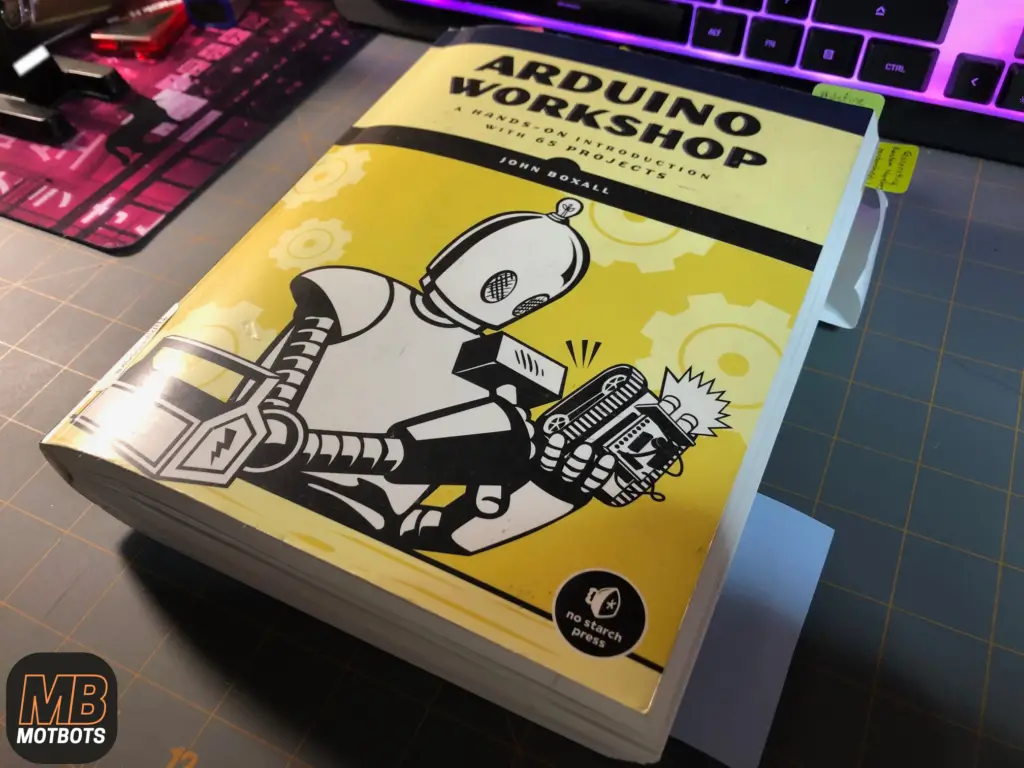
- Python Crash Course, 3rd Edition: A Hands-On, Project-Based Introduction to Programming, by Eric Matthes: I own the 2nd edition of this book and it was very helpful in getting me to understand the basics of Python Programming. This book is the world’s best-selling guide to the Python programming language. This fast-paced, thorough introduction will have you writing programs, solving problems, and developing functioning applications in no time.
- Automate the Boring Stuff with Python, 2nd Edition: Practical Programming for Total Beginners, by Al Sweigart: I own the 1st edition of this book and have used it extensively to recall programming concepts for projects. It’s an excellent book on Python and very engaging through its programming projects. With this book you’ll learn how to code while you write programs that effortlessly perform useful feats of automation!
Intermediate Books
Intermediate books are books written for those who have some knowledge and experience in electronics, robotics, and programming. Someone who is considered to be at the intermediate level in robotics already has knowledge on the basics of electronics and robotics, knows the fundamentals of a programming language, and has already completed one or more robot projects. Books for intermediate level learners provide a more in-depth understanding of the fundamentals, as well as expand on other topics of interest in the electronics and robotics field.
Teens and Adults Ages 13+
Electronics
- Make: More Electronics: Journey Deep Into the World of Logic Chips, Amplifiers, Sensors, and Randomicity, by Charles Platt: An extension of the book Make: Electronics written by the same author, Make: More Electronics picks up where Make: Electronics left off. In this book you’ll work with components like comparators, light sensors, higher-level logic chips, multiplexers, shift registers, encoders, decoders, and magnetic sensors. This book provides step-by-step instructions, and hundreds of color photographs and illustrations, and will help you use and understand intermediate to advanced electronics concepts and techniques.
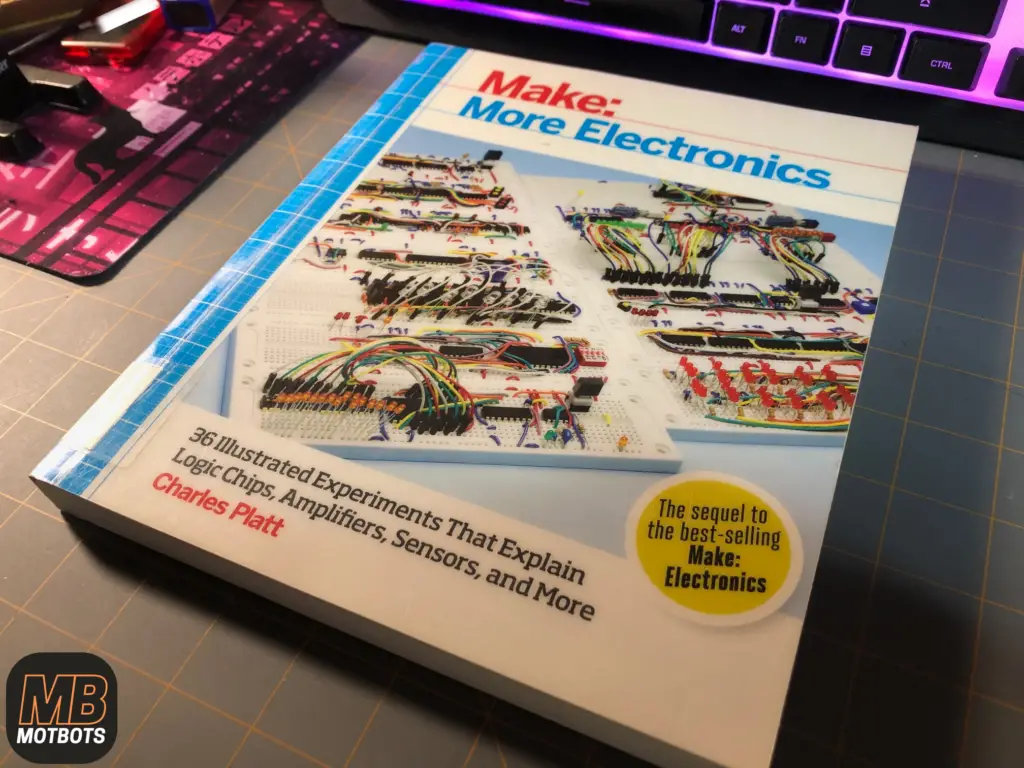
- Practical Electronics for Inventors, by Paul Scherz and Simon Monk: I have recommended this book under beginner books for “Teens and Adults Ages 13+” above, but it also dives deeper into the world of electronics for the intermediate learner. I actually own this book and it provides a wealth of information from the beginner level up to an advanced level. If you’re in the market for getting yourself a book on electronics to really learn as much as you can on the subject material, then this book is an excellent choice. This book will provide a strong foundation in your electronics knowledge and skills that will carry over directly to everything you’ll do more in robotics.
Robotics
- Mechanical Engineering for Makers: A Hands-on Guide to Designing and Making Physical Things, by Brian Bunnell and Samer Najia: The description of this book states that it is a user-friendly reference book of common mechanical engineering concepts, and is geared toward makers who don’t have (or want) an engineering degree but need to know the essentials of basic mechanical elements to successfully accomplish their personal projects. A book like this will add to your knowledge of mechanical concepts that transitions over to the field of robotics.
- Robot Builder’s Bonanza, 5th Edition, by Gordon McComb: I have the 4th edition of this book and it is a great way to get hands-on experience in robotics. The 5th edition of this book describes that it’s a robot builder’s paradise packed with more than 100 affordable projects, including 10 completely new robot designs. The projects are modular and can be combined to create a variety of highly intelligent and workable robots of all shapes and sizes. Mix and match the projects to develop your own unique creations. The only limit is your imagination! I definitely recommend this book, and recommend that if you get it to methodically go through each project and soak up the invaluable information about robotics design it has to offer within its pages.
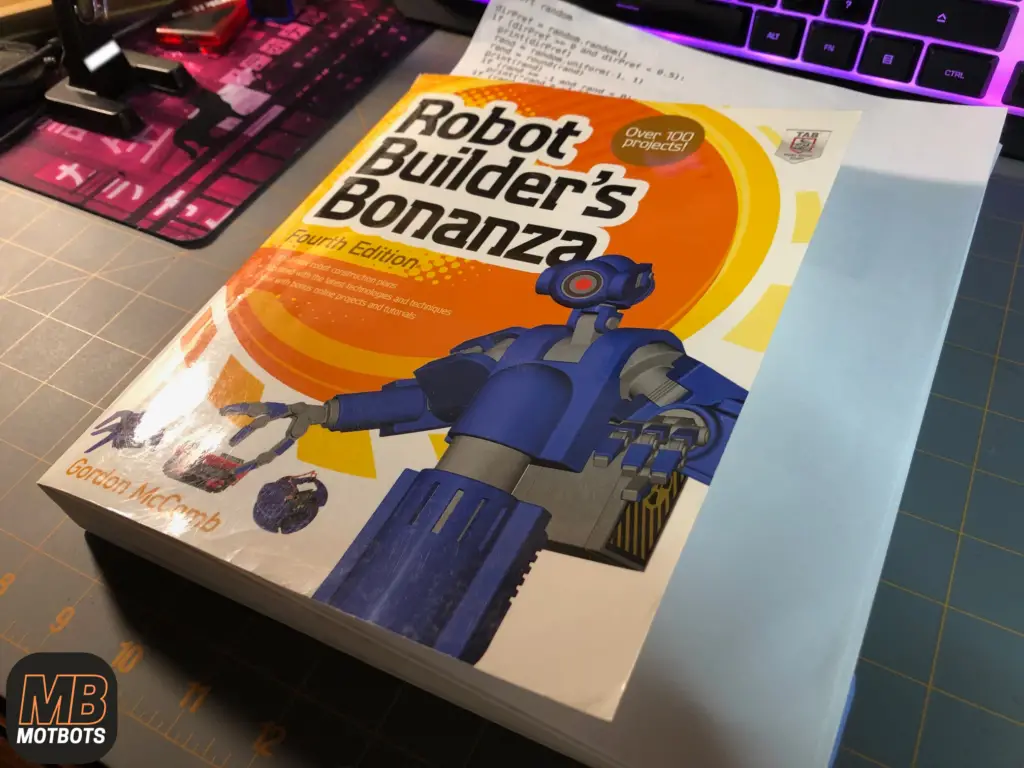
- Make a Raspberry Pi-Controlled Robot: Building a Rover with Python, Linux, Motors, and Sensors, by Wolfram Donat: I bought this book a while back ago, but I must admit that as of writing this blog post I have not used it yet. The book states that it teaches you how to build a Raspberry-Pi Controlled Robot that is capable and upgradeable as a personal robot for around $100. You’ll learn how to control servos, respond to sensor input, and know where your bot is using GPS. The book says that you’ll also learn many ways to connect to your robot and send it instructions, from an SSH connection to sending text messages from your phone.
- Learn Robotics Programming: Build and control autonomous robots using Raspberry Pi 3 and Python, by Danny Staple: This book gets you up to speed with the fundamentals of robotic programming and build intelligent robots. You’ll learn how to program a voice agent to control and interact with your robot’s behavior, as well as enable your robot to see its environment and avoid barriers using sensors.
- Build Your Own Robot: Using Python, CRICKIT, and Raspberry PI, by Marwan Alsabbagh: This book introduces you to the exciting world of robotics in a way that’s fun and affordable! You’ll build your own real robot with easy-to-find hardware and free open source software. Plus, all the components you need can be assembled with simple tools like a screwdriver.
Programming
- Exploring Arduino: Tools and Techniques for Engineering Wizardry, by Jeremy Blum: This book states that it will help the reader learn step-by-step everything one needs to know about electrical engineering (a sub-field of robotics), programming, and human-computer interaction through a series of increasingly complex projects using the Arduino platform. You’ll learn servo motors, stepper motors, wireless connectivity and the internet-of-things all in this one book.
- Programming Arduino Next Steps: Going Further with Sketches, by Simon Monk: In this book you’ll go beyond the basics of Arduino programming and take your skills to the next level. Aimed at programmers and hobbyists who have mastered the fundamentals, this book reveals professional programming tricks and tips. You’ll learn things like configure your Arduino IDE and develop your own sketches, how to boost performance and speed by writing time-efficient sketches, as well as optimize power consumption and memory usage, and much more.
- Arduino Cookbook: Recipes to Begin, Expand, and Enhance Your Projects, by Michael Margolis and Brian Jepson: I bought the 2nd edition of this book years ago, not long after its 2011 release, when I was new to the world of Arduino. It wasn’t for a novice like myself at the time, but once I learned more about the basics of Arduino through other resources, I came back to this book and realized how many resources this book had to offer. The 3rd edition of this cookbook is perfect for anyone who wants to experiment with the popular Arduino microcontroller and programming environment. You’ll find more than 200 tips and techniques for building a variety of objects and prototypes such as IoT solutions, environmental monitors, location and position-aware systems, and products that can respond to touch, sound, heat, and light. I highly recommend this book, once you’ve learned the basics, and use this book extensively for any projects you want to implement with Arduino.

Advanced Books
Advanced books are for those individuals who are very knowledgeable in electronics and circuits, has an extensive knowledge in a programming language, and has had an extensive background in designing and building robots. These lists of books assume you are at the advanced level to be able to perform the tasks and projects within the books. Note, that extreme caution may need to be taken for some books recommended below. The following books have been placed under the age bracket “Teens and Adults Ages 13+”, but please keep in mind that there may need to be some adult supervision for some projects attempted by folks under the age of 18. As for adults, you should know better and have obtained some common sense at some point in life. With that said, be safe and enjoy!
Teens and Adults Ages 13+
Robotics
- Building Bots: Designing and Building Warrior Robots, by William Gurstelle: I own this book and must admit that I have not built a warrior robot from this book. I bought it long ago because I wanted to know how to build my very own warrior robot. That being said though, I have looked through the book before and it does offer great information on building your very own warrior robot. This book states that it walks robot enthusiasts of all ages step-by-step through the design and building process, enabling them to create any number of customized warrior robots. Safety, of course is emphasized throughout the book.
- Robot Wars: Build your own Robot (Haynes Manuals), by James Cooper: This book is somewhat an oldie, but a goody. I also own this book and must admit that I have not built a battle robot myself from this book. That being said though, I have looked through the book before and it does offer great information on building your very own battle robots. The book states that this manual will provide a unique behind-the-scenes look at the show Robot Wars—the arena, and both house and competitors’ robots—and will provide step-by-step extensively illustrated instructions for building three project robots, from a simple ‘self-navigating’ robot, to a fully controllable Robot Wars challenger.
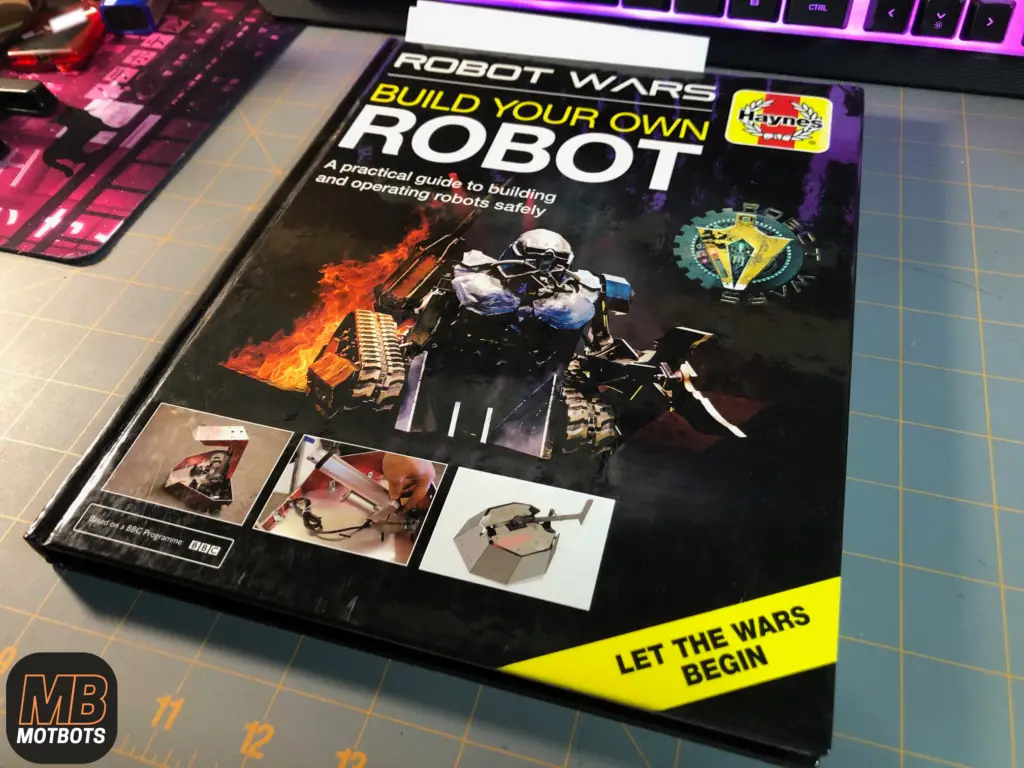
Programming
- Learn Robotics Programming – Second Edition: Build and control AI-enabled autonomous robots using the Raspberry Pi and Python, by Danny Staple: If you’re looking to develop an extendable smart robot capable of performing a complex series of actions with Python and Raspberry Pi, then this book is for you. In this book you’ll learn to leverage the features of the Raspberry Pi OS, discover how to configure a Raspberry Pi to build an AI-enabled robot, interface motors and sensors with a Raspberry Pi, and much more.
- Practical Robotics in C++: Build and Program Real Autonomous Robots Using Raspberry Pi, by Lloyd Brombach: I am a recent owner of this book and have not used it yet, as of the writing of this blog post, but I just had to buy it based on its positive reviews and my desire to further my own knowledge on the C++ programming language as it pertains to robotics. In this book you’ll learn to write code for a motor drive controller, build a map from Lidar data, write and implement your own autonomous path-planning algorithm, and learn to do a whole lot of more cool stuff. I myself am excited to get into this book, hopefully soon!
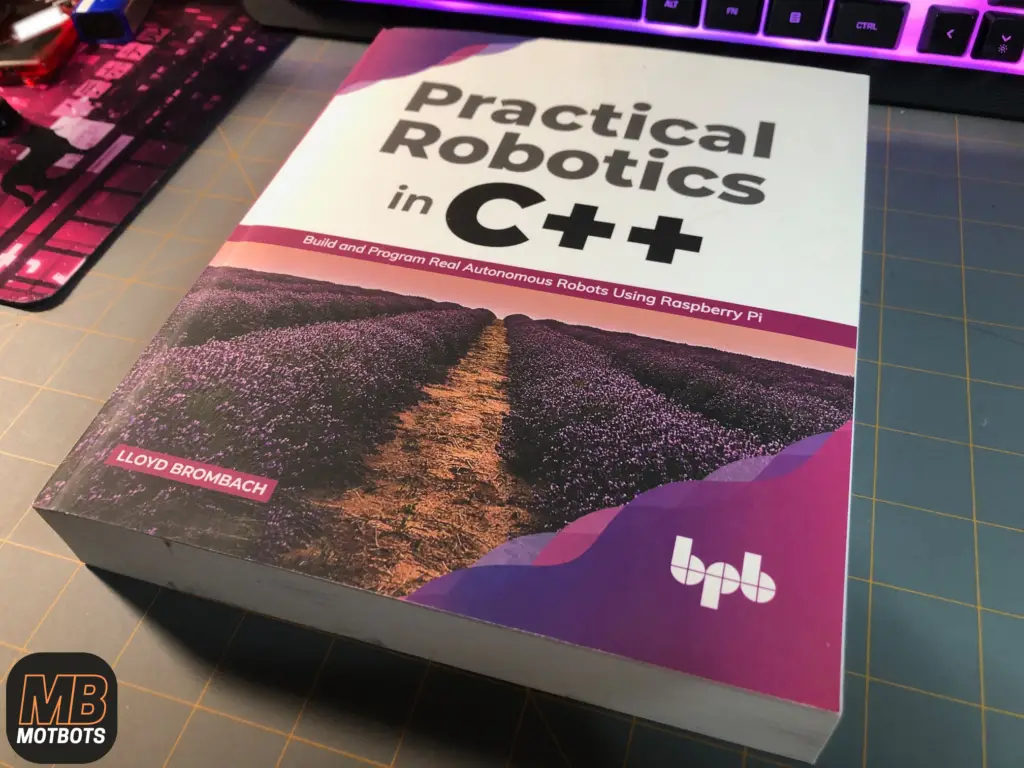
Conclusion
I think at this point, we’ve gone over enough books to get you started from whatever skill level you or someone you know are currently at. Each book that has been listed within this blog post would be beneficial to anyone looking to broaden and develop their robotics skills and capabilities.
I hope that this blog post was able to enlighten you to the literal library of books out there available to a robotics enthusiast. I also hope that the categorizing of ages, skill sets, and skill categories was beneficial to you. It was my hope that it would make it easier for you to look into the contents that are specific to one’s age and skill set.
Now all that’s left to do is go out there, learn as much as you can, and start building!
